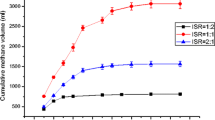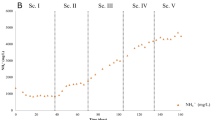Abstract
The anaerobic acidification of protein-rich algal residues with pH control (4, 6, 8, 10) was studied in batch reactors, which was operated at mesophilic(35 °C) condition. The distribution of major volatile fatty acids (VFAs) during acidogenesis was emphasized in this paper. The results showed that the acidification efficiency and VFAs distribution in the acid reactor strongly depended on the pH. The main product for all the runs involved acetic acid except that the proportion of butyric acid acidified at pH 6 was relatively higher. The other organic acids remained at lower levels. The VFAs yield reached the maximum value with about 0.6 g VFAs/g volatile solid (VS) added as pH was 8, and also the content of total ammonia nitrogen (TAN) reached the highest values of 9,629 mg/l. Low acidification degrees were obtained under the conditions at pH 4 and 10, which was not suitable for the metabolism of acidogens. Hydralic retention time (HRT) required for different conditions varied. As a consequence, it was indicated that pH was crucial to the acidification efficiency and products distribution. The investigation of acidogenesis process, which was producing the major substrates, short-chain fatty acids, would play the primary role in the efficient operation of methanogenesis.






Similar content being viewed by others
References
Breure AM, Andel JG (1984) Hydrolysis and acidogenic fermentation of a protein gelatin in an anaerobic continuous culture. Appl Microbiol Biotechnol 20:40–45
Breure AM, Andel JG, Burger-Wiersma T (1984) The anaerobic acidification of gelatin in continuous culture by a mixed population bacteria. J Microbiol 50:78
Chae KJ, Jang A, Yim SK, Kim IS (2008) The effects of digestion temperature and temperature shock on the biogas yields from the mesophilic anaerobic digestion of swine manure. Bioresour Technol 99:1–6
Chen Y, Zhou JW, Wen Y, Zhou Q (2011) Effects of pH on litter hydrolysis and short-chain fatty acids accumulation. Environ Pollut Control 33:11–14
Chisti Y (2007) Biodiesel from microalgae. Biotechnol Adv 25:294–306
Chisti Y (2008) Biodiesel from microalgae beats bioethanol. Trends Biotechnol 26:126–131
Chynoweth DP, Owens JM, Legrand R (2000) Renewable methane from anaerobic digestion of biomass. Renewable Energy 22:1–8
Demirbas A, Demirbas MF (2011) Importance of algae oil as a source of biodiesel. Energy Convers Manag 88:3473–3480
Ehimen EA, Connaughton S, Sun Z, Carrington CG (2009) Energy recovery from lipid extracted transesterified and glycerol co-digested microalgae biomass. GCB Bioenergy 1:371–381
Forster-Carneiro T, Pérez M, Romero LI (2008) Influence of total solid and inoculum contents on performance of anaerobic reactors treating food waste. Bioresour Technol 99:6994–7002
Horiuchi JI, Shimizu T, Tada K (2002) Selective production of organic acids in anaerobic acid reactor by pH control. Bioresour Technol 82:209–213
Huang GH, Chen F, Wei D, Zhang XW, Chen G (2010) Biodiesel production by microalgal biotechnology. Appl Energy 87:38–46
Kaparaju P, Ellegaard L, Angelidaki I (2009) Optimisation of biogas production from manure through serial digestion:lab-scale and pilot-scale studies. Bioresour Technol 100:701–709
Kayhanian M (1999) Ammonia inhibition in high-solids biogasification: an overview and practical solutions. Environ Technol 2:355–365
Komatsu T, Hanaki K, Matsuo T (1991) Prevention of lipid inhibition in anaerobic processes by introducing a two-phase system. Water Sci Technol 23:1189–1200
Li YX, Liu H, Du GC, Chen J (2010) Enhanced production of volatile fatty acids from waste algae in Taihu Lake under Alkaline Conditions. Chinese J Environ eng. 4:209–213
Liu H, Liu XL, Zhang JJ, Che J (2009) Acetate accumulation and shift of bacterial community during anaerobic sewage sludge fermentation by pH adjustment. Acta Microbiologica Sinica 49:1643–1649
Markou G, Georgakakis D (2011) Cultivation of filamentous cyanobacteria (blue-green algae) in agro-industrial wastes and wastewaters: a review. Appl Energy 88:3389–3401
Murphy JD, McKeogh E, Kiely G (2004) Technical/economic/environmental analysis of biogas utilization. Appl Energy 77:407–427
Penaud V, Delgenes JP, Torrijos M, Moletta R, Vanhoutte B, Cans P (1997) Definition of optimal conditions for the hydrolysis and acidogenesis of a pharmaceutical microbial biomass. Process Biochem 32:515–521
Ponsá S, Ferrer I, Vázquez F, Font X (2008) Optimization of the hydrolytic- acidogenic anaerobic digestion stage (55 °C) of sewage sludge: influence of pH and solid content. Water Res 42:3972–3980
Razon LF, Tan RR (2011) Net energy analysis of the production of biodiesel and biogas from the microalgae:haematococcus pluvialis and Nannochloropsis. Appl Energy 88:3507–3514
Sialve B, Bernet N, Bernard O (2009) Anaerobic digestion of microalgae as a necessary step to make microalgal biodiesel sustainable. Biotechnol Adv 27:409–416
Xu SY, Lam HP, Karthikeyan OP, Wong JWC (2011) Optimization of food waste hydrolysis in leach bed coupled with methanogenic reactor: effect of pH and bulking agent. Bioresour Technol 102:3702–3708
Zhao D, Ren NQ, W AJ (2003) Fermentation Type and Climax Community Controlled by pH, ORP. Chongqing Environ Sci 25:33–35
Zoetemeyer RJ, Heuvel JC, Cohen A (1982) pH influence on acidogenic dissimilation of glucose in anaerobic digester. Water Res 16:303–311
Acknowledgments
This study was funded by Twelfth Five-Year Plan of National Science and Technology (No. 2011BAD14B03), State “863″ projects (No. 2012AA101803) and Natural Science Foundation of Shandong province (ZR2012BL16).
Author information
Authors and Affiliations
Corresponding author
Rights and permissions
About this article
Cite this article
Li, Y., Hua, D., Zhang, J. et al. Volatile fatty acids distribution during acidogenesis of algal residues with pH control. World J Microbiol Biotechnol 29, 1067–1073 (2013). https://doi.org/10.1007/s11274-013-1270-z
Received:
Accepted:
Published:
Issue Date:
DOI: https://doi.org/10.1007/s11274-013-1270-z




